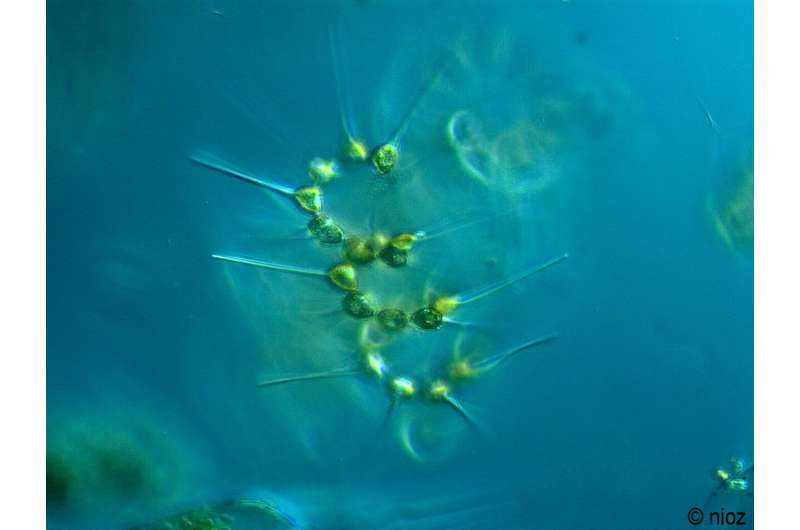Microphytobenthos in the Dutch Wadden Sea feed on 'left-overs' from the bottom

The Wadden Sea is an extremely productive ecosystem whose food web is supported by benthic organisms, feeding on primary producers. In a recent publication in Frontiers in Ecology and Evolution, NIOZ marine biogeochemist dr. Philip Riekenberg and colleagues show where (part of) this exceptional productivity may come from.
"For example, diatoms on intertidal mudflats are supported by the nitrogen remaining from recycled detritus in the porewaters between the grains of sand," Riekenberg says. "They feed on the processed left-overs in the bottom, so to speak."
Isotopes
For the study, Riekenberg and colleagues looked at the chemical variations in the isotopes of nitrogen. There are two predominant forms of nitrogen, 'nitrogen-14' and the heavier version, 'nitrogen-15'.
When an organism digests protein, for example from plankton, the resulting nitrogen is used to create its own proteins. In this process, the lighter nitrogen-14 is lost a bit, so the relative concentration of the heavy nitrogen increases a little at each step in the food chain. As a result, animals higher up the food chain retain relatively more and more nitrogen-15.
In recent years, it has become possible to also analyze the different nitrogen isotopes from individual amino acids. Certain amino acids (the building blocks of protein) cannot be created by higher organisms themselves. As a result, those essential or 'source amino acids' need to be obtained from the diet and remain mostly unchanged throughout the food chain. Therefore, in these amino acids, the stable isotope ratio of nitrogen does not become progressively higher with each step of eating or being eaten.
Other, so-called trophic amino acids do change a lot during metabolism through each step of the food chain. Thus, the difference in nitrogen composition between trophic and essential amino acids provides a measure of how high up the food chain an organism is, independent of any variations in underlying nitrogen sources supporting the ecosystem. We used this technique to build a trophic structure from direct measurements of the Dutch Wadden Sea food web.
Detritus in the pore water
Using samples that were collected between 2011 and 2014 during the long-lasting monitoring program of NIOZ, SIBES (the Synoptic Intertidal BEnthic Survey), Riekenberg analyzed the nitrogen isotopes of amino acids from 340 different animals from across the Dutch Wadden Sea. Thus, he was able to trace back the sources of nitrogen that these animals used.
Riekenberg says, "We saw that quite a bit of the nitrogen did not come from the overlying water column, but from the benthic primary producers, like diatoms, using nitrogen from the pore water at the bottom of the Wadden Sea. This nitrogen has a distinct signal, since it is what remains after the breaking down of organic matter and denitrification, and can therefore be tracked into a portion of the food web."
Riekenberg stresses that this new piece of the jigsaw adds important knowledge to the science of the Wadden Sea ecosystem. "Now that we know that detrital nitrogen in porewaters is an important direct source of nutrients, this should be included in ecological models we make of the Wadden Sea. If our models do not include all pools of nutrients supporting the food web, then how can these models accurately reflect the ecology of the Wadden Sea when they are used to predict future impacts or changes?"
More information: Philip M. Riekenberg et al, Compound-specific stable isotope analysis of amino acid nitrogen reveals detrital support of microphytobenthos in the Dutch Wadden Sea benthic food web, Frontiers in Ecology and Evolution (2022). DOI: 10.3389/fevo.2022.951047
Journal information: Frontiers in Ecology and Evolution
Provided by Royal Netherlands Institute for Sea Research

















